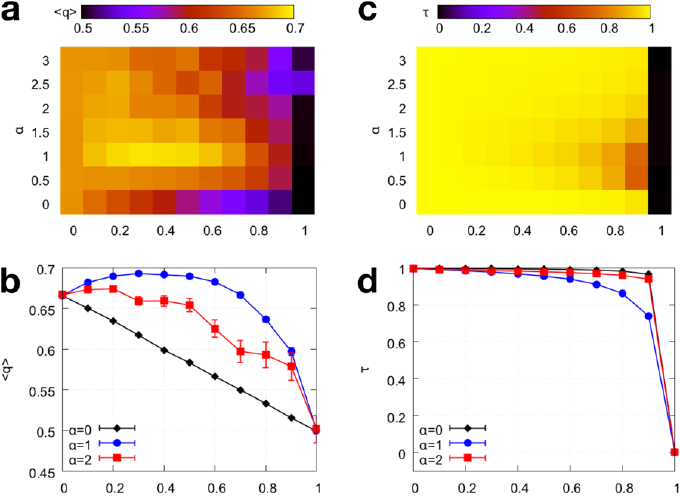 Effects of popularity bias on average quality and faithfulness from model simulations. (a) Heatmap of average quality $\bar{q}$ as a function of $\alpha$ and $\beta$, showing that popularity bias can either hinder or promote average quality depending on exploration cost. (b) The location of the maximum $\bar{q}$ as a function of $\beta$ depends on $\alpha$, here shown for $\alpha = 0, 1, 2$. When $\alpha = 1$ an intermediate amount of popularity bias is optimal. (c) Faithfulness $\tau$ of the algorithm as a function of $\alpha$ and $\beta$. (d) $\tau$ as a function of $\beta$ for the same three values of $\alpha$. Standard errors are shown in panels ({b,d}) and are smaller than the markers if not visible.
Effects of popularity bias on average quality and faithfulness from model simulations. (a) Heatmap of average quality $\bar{q}$ as a function of $\alpha$ and $\beta$, showing that popularity bias can either hinder or promote average quality depending on exploration cost. (b) The location of the maximum $\bar{q}$ as a function of $\beta$ depends on $\alpha$, here shown for $\alpha = 0, 1, 2$. When $\alpha = 1$ an intermediate amount of popularity bias is optimal. (c) Faithfulness $\tau$ of the algorithm as a function of $\alpha$ and $\beta$. (d) $\tau$ as a function of $\beta$ for the same three values of $\alpha$. Standard errors are shown in panels ({b,d}) and are smaller than the markers if not visible.
 Effects of popularity bias on average quality and faithfulness from model simulations. (a) Heatmap of average quality $\bar{q}$ as a function of $\alpha$ and $\beta$, showing that popularity bias can either hinder or promote average quality depending on exploration cost. (b) The location of the maximum $\bar{q}$ as a function of $\beta$ depends on $\alpha$, here shown for $\alpha = 0, 1, 2$. When $\alpha = 1$ an intermediate amount of popularity bias is optimal. (c) Faithfulness $\tau$ of the algorithm as a function of $\alpha$ and $\beta$. (d) $\tau$ as a function of $\beta$ for the same three values of $\alpha$. Standard errors are shown in panels ({b,d}) and are smaller than the markers if not visible.
Effects of popularity bias on average quality and faithfulness from model simulations. (a) Heatmap of average quality $\bar{q}$ as a function of $\alpha$ and $\beta$, showing that popularity bias can either hinder or promote average quality depending on exploration cost. (b) The location of the maximum $\bar{q}$ as a function of $\beta$ depends on $\alpha$, here shown for $\alpha = 0, 1, 2$. When $\alpha = 1$ an intermediate amount of popularity bias is optimal. (c) Faithfulness $\tau$ of the algorithm as a function of $\alpha$ and $\beta$. (d) $\tau$ as a function of $\beta$ for the same three values of $\alpha$. Standard errors are shown in panels ({b,d}) and are smaller than the markers if not visible.
Abstract
Algorithms that favor popular items are used to help us select among many choices, from top-ranked search engine results to highly-cited scientific papers. The goal of these algorithms is to identify high-quality items such as reliable news, credible information sources, and important discoveries-in short, high-quality content should rank at the top. Prior work has shown that choosing what is popular may amplify random fluctuations and lead to sub-optimal rankings. Nonetheless, it is often assumed that recommending what is popular will help high-quality content “bubble up” in practice. Here we identify the conditions in which popularity may be a viable proxy for quality content by studying a simple model of a cultural market endowed with an intrinsic notion of quality. A parameter representing the cognitive cost of exploration controls the trade-off between quality and popularity. Below and above a critical exploration cost, popularity bias is more likely to hinder quality. But we find a narrow intermediate regime of user attention where an optimal balance exists: choosing what is popular can help promote high-quality items to the top. These findings clarify the effects of algorithmic popularity bias on quality outcomes, and may inform the design of more principled mechanisms for techno-social cultural markets.